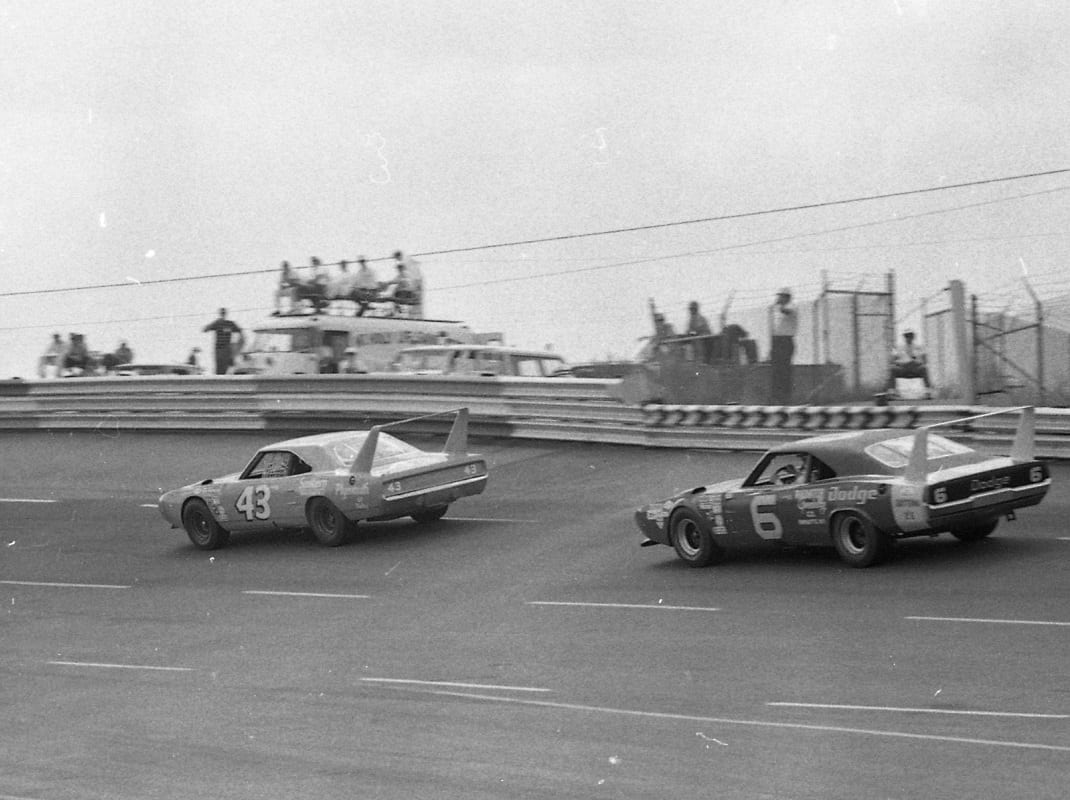Bob Moore, a motorsports writer and public relations representative for nearly 60 years, remembers being surprised at the sight of what Chrysler had to offer.
“The Dodge Daytonas and Plymouth Superbirds looked like they could fly and should have been at an airport somewhere,” Moore said recently. “They were completely radical as far as stock car standards. At 200 mph, drivers said they handled very well and raced very well. It seemed like an odd-ball attraction when they first were introduced, but they produced some very good racing.
“To make it legal to race in NASCAR, Chrysler had to make a minimum of 500 of them for street use and they did. They were quite popular among fans.”
Petty logged 10 wins for Ford in ’69 but his much-anticipated homecoming to Chrysler filled newspaper headlines during the offseason.
“Before, I had signed only one-year deals with Chrysler and that was what I signed with Ford,” Petty said in the January 1993 issue of American Racing Classics. “But the deal to return (to Chrysler) was for a lot more than one year. That’s why we had the deal in 1971 after they cut way back.”
Harry Hyde, the noted crew chief for 1970 GN champion Bobby Isaac, loved the car because of its on-track performance and the relatively easy adjustments to the wing.
“There is no telling how fast they would have run,” Hyde said in the 1993 ARC article. “Two-hundred-eighty miles per hour would not have been out of the question with the tires we have today. But it’s really just a guess as they were almost the perfect race car. They were so stable. They had real low drag numbers (in the wind tunnel) and we all know how important low drag numbers have become.
“You could just tilt the wing and make the car either loose or tight, whatever you wanted. No matter what the driver wanted, if you tilted the wing, you could give it to him. The wing was tilted 11 degrees to start with and this was almost perfect. But if you needed, you could change the handling of the car just by tilting the wing. They were the easiest cars I’ve ever had to work with but NASCAR could see they were too fast even back then. The speeds were getting almost out of control.”
Even though scheduled to run in 1970, Chrysler entered the Dodge Daytonas in the inaugural race at Talladega on Sept. 14, 1969. They were so fast that the tires wouldn’t hold up, causing many top drivers to leave early in protest. Richard Brickhouse drove a Ray Nichels’s winged Dodge Daytona to victory.
The 1970 season was much the same with Pete Hamilton winning the Daytona 500 in a Petty Superbird. In August, NASCAR introduced the restrictor plate as a direct result of the winged cars. It was their way to combat the even higher speeds feared to come in 1971. Further rule changes in essence killed the car’s competitiveness, almost as if they were too exotic and much too different to be dubbed “stock cars.” Being given a maximum engine size of 305 cubic inches sealed their fate.
Chrysler had already planned to phase out the winged cars when the rules were released from NASCAR’s headquarters in Daytona Beach, Fla., citing they would only back Petty Enterprises with Petty in a Plymouth and Buddy Baker in a Dodge. That left other top Chrysler team owners such as Mario Rossi, Cotton Owens, Nord Krauskopf and Nichels scrambling to figure out their futures.
Dick Brooks was the last to run a Dodge Daytona, owned by Rossi, in NASCAR competition during the 1971 Daytona 500. With the underpowered 305 engine, Brooks led five laps and finished eighth.
With that, NASCAR’s era of the winged car was over.
